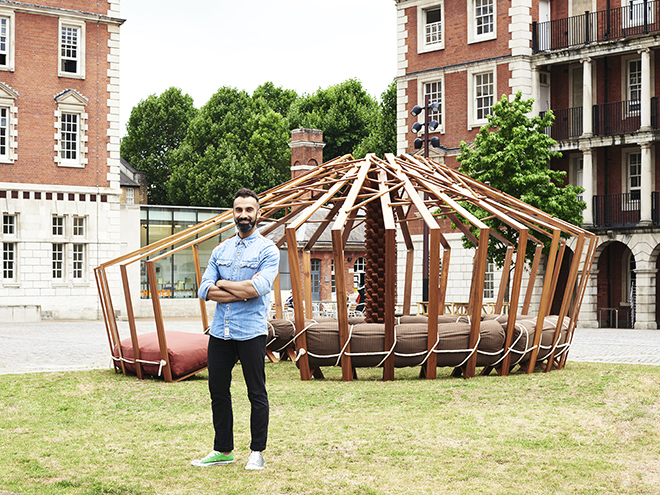Written by Jamie Etheridge • Photos courtesy of Khalid Shafar
Contemporary style is all about the livable moment. In art, in fashion, in design, the contemporary starts with the temporal, with the ever changing, eclectic now. For one leading Emirati designer, contemporary is interpreted not only to mean the here and now but also the how. How will the object be used?
At the core of Khalid Shafar’s designs lies function. Eclectic, contemporary but inspired by 1950s, 1960s and 1970s clean lines and simplicity, Shafar’s telltale designs offer not only livable objects d’art but also stories that inspired their creations. The stories are not hard to read.
Take the gorgeous travertine marble and ashwood coffee table, The Auction. According to Shafar, the “inspiration for this coffee table comes from a very old story of my childhood. I grew up seeing men roaming the neighborhood carrying sacks filled with merchandise that they sold to housewives. These roaming salesmen used to announce their presence in the neighborhood by shouting, ‘Lelam’ a Malayalam word that means ‘auction’, which refers to the type of transaction these men made with the housewives. From this sack image and the way it was used back in those days, the Auction coffee table was born.”
“I tend to focus on interior objects. Objects with stories. That is the core of its aesthetic: the attachment to the object.”
In 2011, he opened his own studio in Dubai and inaugurated his first showspace, KASA. A rising star of Middle Eastern design, Shafar has quickly become one of the leading creatives in Dubai’s booming design industry.
“My objects are also culturally inspired but contemporarily presented, with a 1950s-60-70s aesthetic but reinterpreted. Simple lines, simple elegance. However there is also always a clear connection to my roots and culture, either through the story of the object, the materials or the inspiration,” Shafar explains.
Born in the UAE in 1980, he studied business at the American University in Dubai and spent seven years in marketing and communication before switching to pursue a passion in design. In 2005, he earned a degree in Fine Arts in Interior Design with a focus on furniture and objects.
Shafar gets his inspiration from the desert landscape in his native United Arab Emirates (UAE). One piece, called the Fallen Palm, brings to mind just that. Made of ash and walnut wood and covered with locally grown goat hair, the Fallen Palm is a bench reminiscent of the locally abundant date palms of the UAE.
Working from concept to sketch, Shafar then translates his idea into a prototype, often in his favorite medium – wood. “Woodworking was the foundation for my learning of the entire practice of design,” Shafar said. It serves as the solid foundation for my practice and allows the piece to be more functional.
A generation of young contemporary designers now travel the globe, gaining experience and inspiration from tailors in New York, wood cutters in New Zealand, palm fronds in Dubai.
Design is a function of ‘crossing breeding and evolution’ Shafar believes and that means he is open to using a variety of materials. His designs also have used locally sourced camel leather, locally cultured pearls and even parts of the local national dress like the headpiece, known as agal.
More recently, the 35 year old designer has ventured into textiles and wallpaper, creating a signature design from the story of the seven different colored sands of the UAE. Shafar has collaborated with leading internationals including the historic French cabinetmaker Moissonnier and the Brazilian duo Campana Brothers on an installation for Abu Dhabi Art 2010. Shafar’s interactive installation, The Nomad, is currently on display at the prestigious Chelsea College of Art, as part of Shubbak, a contemporary Arab culture festival held bi-annually in London.
For a well put together look, Shafar prefers shabby but chic. His wardrobe tends to lean more toward solids over patterns in his shirts and suits, deconstructed jackets. “I like elegant, simple lines but always with a twist.”
“High end sneakers are a must,” he says, noting that they can often be worn casually or for more formal evening events.







